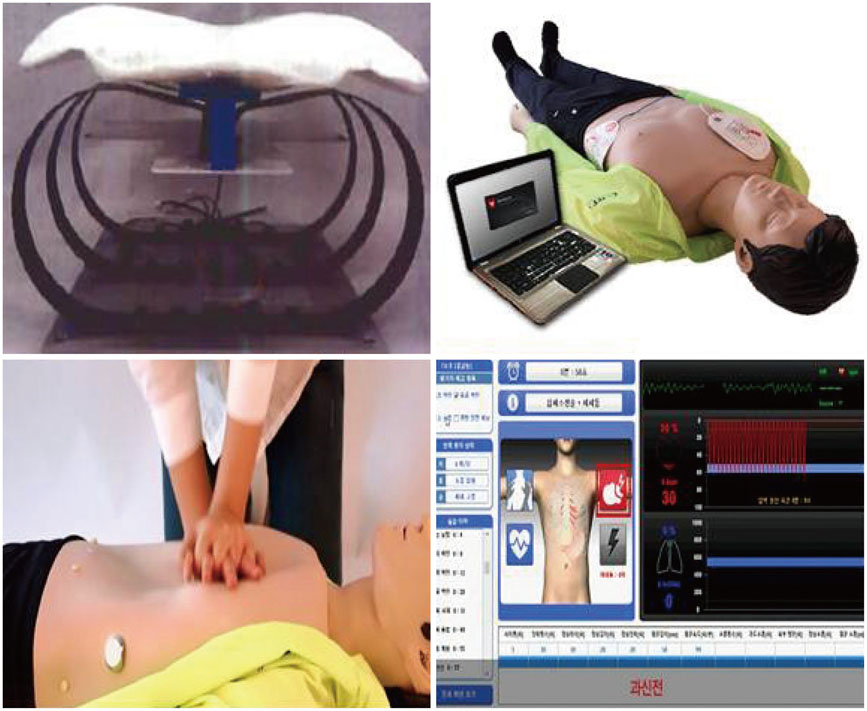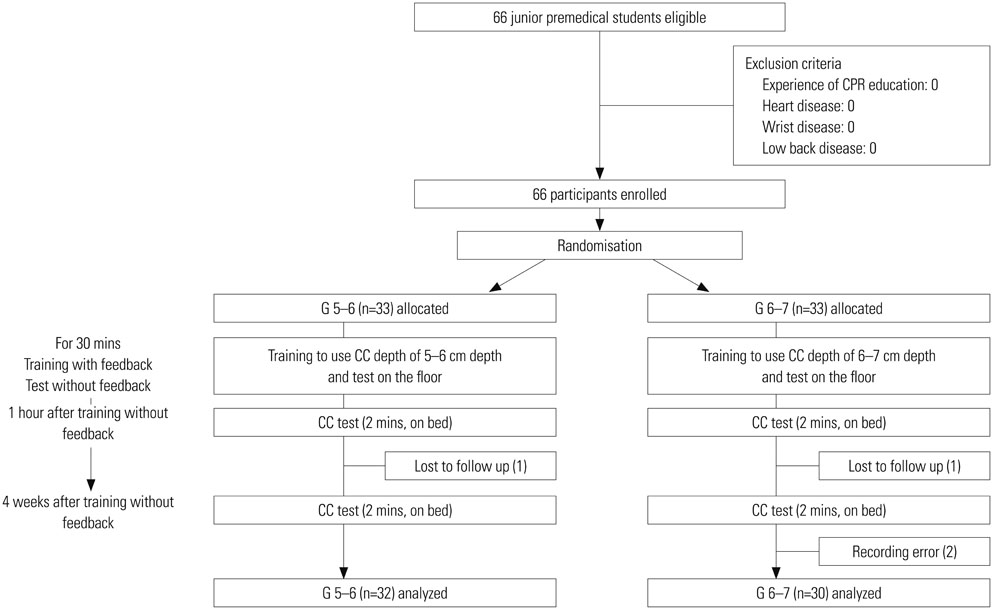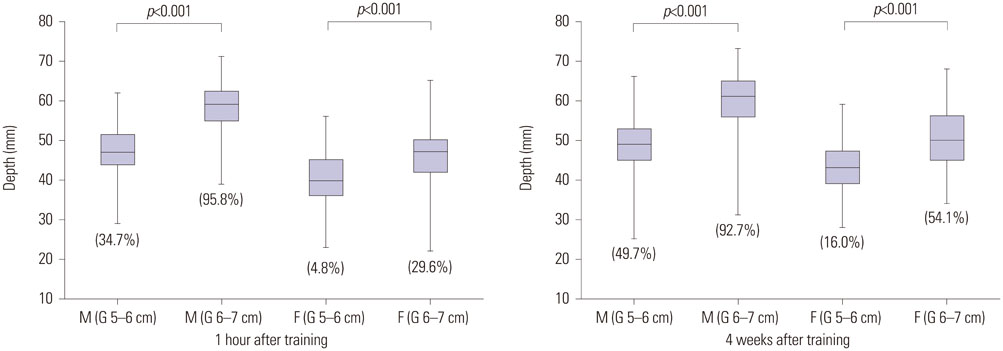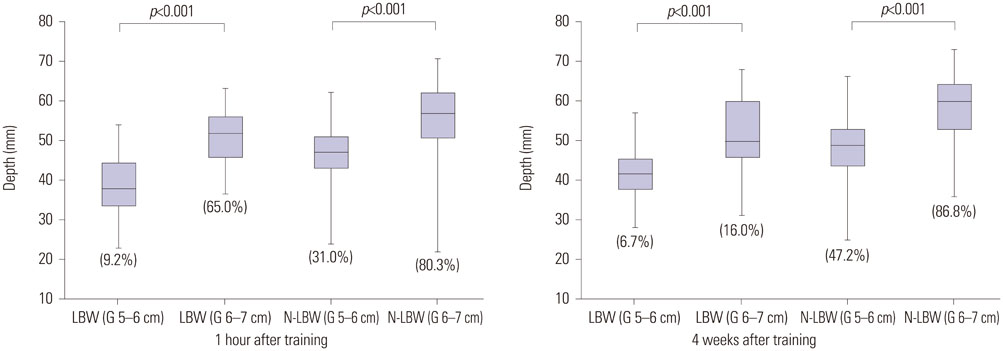Yonsei Med J.
2016 Mar;57(2):505-511. 10.3349/ymj.2016.57.2.505.
Training a Chest Compression of 6-7 cm Depth for High Quality Cardiopulmonary Resuscitation in Hospital Setting: A Randomised Controlled Trial
- Affiliations
-
- 1Department of Emergency Medicine, College of Medicine, Hanyang University, Seoul, Korea. erthim@gmail.com
- 2Department of Emergency Medicine, College of Medicine, Hallym University, Seoul, Korea.
- 3School of Electrical Engineering, University of Ulsan, Ulsan, Korea.
- 4Department of Biomedical Engineering Medicine, College of Medicine, Hanyang University, Seoul, Korea.
- KMID: 2374060
- DOI: http://doi.org/10.3349/ymj.2016.57.2.505
Abstract
- PURPOSE
During cardiopulmonary resuscitation (CPR), chest compression (CC) depth is influenced by the surface on which the patient is placed. We hypothesized that training healthcare providers to perform a CC depth of 6-7 cm (instead of 5-6 cm) on a manikin placed on a mattress during CPR in the hospital might improve their proper CC depth.
MATERIALS AND METHODS
This prospective randomised controlled study involved 66 premedical students without CPR training. The control group was trained to use a CC depth of 5-6 cm (G 5-6), while the experimental group was taught to use a CC depth of 6-7 cm (G 6-7) with a manikin on the floor. All participants performed CCs for 2 min on a manikin that was placed on a bed 1 hour and then again 4 weeks after the training without a feedback. The parameters of CC quality (depth, rate, % of accurate depth) were assessed and compared between the 2 groups.
RESULTS
Four students were excluded due to loss to follow-up and recording errors, and data of 62 were analysed. CC depth and % of accurate depth were significantly higher among students in the G 6-7 than G 5-6 both 1 hour and 4 weeks after the training (p<0.001), whereas CC rate was not different between two groups (p>0.05).
CONCLUSION
Training healthcare providers to perform a CC depth of 6-7 cm could improve quality CC depth when performing CCs on patients who are placed on a mattress during CPR in a hospital setting.
Keyword
MeSH Terms
Figure
Reference
-
1. Soar J, Perkins GD, Nolan JP. Chest compression quality--push hard, push fast, but how deep and how fast? Crit Care Med. 2012; 40:1363–1364.
Article2. Stiell IG, Brown SP, Christenson J, Cheskes S, Nichol G, Powell J, et al. What is the role of chest compression depth during out-of-hospital cardiac arrest resuscitation? Crit Care Med. 2012; 40:1192–1198.
Article3. Edelson DP, Abella BS, Kramer-Johansen J, Wik L, Myklebust H, Barry AM, et al. Effects of compression depth and pre-shock pauses predict defibrillation failure during cardiac arrest. Resuscitation. 2006; 71:137–145.
Article4. Bellamy RF, DeGuzman LR, Pedersen DC. Coronary blood flow during cardiopulmonary resuscitation in swine. Circulation. 1984; 69:174–180.
Article5. Berg RA, Hemphill R, Abella BS, Aufderheide TP, Cave DM, Hazinski MF, et al. Part 5: adult basic life support: 2010 American Heart Association Guidelines for Cardiopulmonary Resuscitation and Emergency Cardiovascular Care. Circulation. 2010; 122:18 Suppl 3. S685–S705.6. Koster RW, Baubin MA, Bossaert LL, Caballero A, Cassan P, Castrén M, et al. European Resuscitation Council Guidelines for Resuscitation 2010 Section 2. Adult basic life support and use of automated external defibrillators. Resuscitation. 2010; 81:1277–1292.
Article7. Wik L, Kramer-Johansen J, Myklebust H, Sørebø H, Svensson L, Fellows B, et al. Quality of cardiopulmonary resuscitation during out-of-hospital cardiac arrest. JAMA. 2005; 293:299–304.
Article8. Abella BS, Alvarado JP, Myklebust H, Edelson DP, Barry A, O'Hearn N, et al. Quality of cardiopulmonary resuscitation during in-hospital cardiac arrest. JAMA. 2005; 293:305–310.
Article9. Perkins GD, Benny R, Giles S, Gao F, Tweed MJ. Do different mattresses affect the quality of cardiopulmonary resuscitation? Intensive Care Med. 2003; 29:2330–2335.
Article10. Tweed M, Tweed C, Perkins GD. The effect of differing support surfaces on the efficacy of chest compressions using a resuscitation manikin model. Resuscitation. 2001; 51:179–183.
Article11. Nishisaki A, Nysaether J, Sutton R, Maltese M, Niles D, Donoghue A, et al. Effect of mattress deflection on CPR quality assessment for older children and adolescents. Resuscitation. 2009; 80:540–545.
Article12. Perkins GD, Smith CM, Augre C, Allan M, Rogers H, Stephenson B, et al. Effects of a backboard, bed height, and operator position on compression depth during simulated resuscitation. Intensive Care Med. 2006; 32:1632–1635.
Article13. Oh J, Kang H, Chee Y, Lim T, Song Y, Cho Y, et al. Use of backboard and deflation improve quality of chest compression when cardiopulmonary resuscitation is performed on a typical air inflated mattress configuration. J Korean Med Sci. 2013; 28:315–319.
Article14. Perkins GD, Fossan H, Field R, Akhtar N, Davies R, Fullerton J. Novel smart backboard improves CPR performance. Resuscitation. 2010; 81:S11.
Article15. Oh J, Song Y, Kang B, Kang H, Lim T, Suh Y, et al. The use of dual accelerometers improves measurement of chest compression depth. Resuscitation. 2012; 83:500–504.
Article16. Cloete G, Dellimore KH, Scheffer C, Smuts MS, Wallis LA. The impact of backboard size and orientation on sternum-to-spine compression depth and compression stiffness in a manikin study of CPR using two mattress types. Resuscitation. 2011; 82:1064–1070.
Article17. Oh J, Chee Y, Song Y, Lim T, Kang H, Cho Y. A novel method to decrease mattress compression during CPR using a mattress compression cover and a vacuum pump. Resuscitation. 2013; 84:987–991.
Article18. Delvaux AB, Trombley MT, Rivet CJ, Dykla JJ, Jensen D, Smith MR, et al. Design and development of a cardiopulmonary resuscitation mattress. J Intensive Care Med. 2009; 24:195–199.
Article19. Beesems SG, Koster RW. Accurate feedback of chest compression depth on a manikin on a soft surface with correction for total body displacement. Resuscitation. 2014; 85:1439–1443.
Article20. Handley AJ. In-hospital chest compressions--the patient on a bed. Resuscitation. 2012; 83:795–796.
Article21. Blewer AL, Leary M, Esposito EC, Gonzalez M, Riegel B, Bobrow BJ, et al. Continuous chest compression cardiopulmonary resuscitation training promotes rescuer self-confidence and increased secondary training: a hospital-based randomized controlled trial. Crit Care Med. 2012; 40:787–792.
Article22. Oh JH, Kim CW, Kim SE, Lee SJ, Lee DH. Comparison of chest compressions in the standing position beside a bed at knee level and the kneeling position: a non-randomised, single-blind, cross-over trial. Emerg Med J. 2014; 31:533–535.
Article23. Edelson DP, Call SL, Yuen TC, Vanden Hoek TL. The impact of a step stool on cardiopulmonary resuscitation: a cross-over mannequin study. Resuscitation. 2012; 83:874–878.
Article24. Kim MJ, Park YS, Kim SW, Yoon YS, Lee KR, Lim TH, et al. Chest injury following cardiopulmonary resuscitation: a prospective computed tomography evaluation. Resuscitation. 2013; 84:361–364.
Article25. Hellevuo H, Sainio M, Nevalainen R, Huhtala H, Olkkola KT, Tenhunen J, et al. Deeper chest compression - more complications for cardiac arrest patients? Resuscitation. 2013; 84:760–765.
Article26. Krikscionaitiene A, Stasaitis K, Dambrauskiene M, Dambrauskas Z, Vaitkaitiene E, Dobozinskas P, et al. Can lightweight rescuers adequately perform CPR according to 2010 resuscitation guideline requirements? Emerg Med J. 2013; 30:159–160.
Article27. Neset A, Birkenes TS, Myklebust H, Mykletun RJ, Odegaard S, Kramer-Johansen J. A randomized trial of the capability of elderly lay persons to perform chest compression only CPR versus standard 30:2 CPR. Resuscitation. 2010; 81:887–892.
Article
- Full Text Links
- Actions
-
Cited
- CITED
-
- Close
- Share
- Similar articles
-
- Analysis of chest compression quality according to the metronome setting rate in metronome-assisted cardiopulmonary resuscitation
- Comparison of the Alternating Rescuer Method between Every Minute and Two Minutes During Continuous Chest Compression in Cardiopulmonary Resuscitation According to the 2010 Guidelines
- Does Switching Rescuers Every 2 Minutes Improve the Quality of Chest Compression Provided in Cardiopulmonary Resuscitation?
- The Effect of a Real Time Audiovisual Feedback System on the Quality of Chest Compressions by Trained Personnel during Resuscitation: A Randomized Controlled Trial using a Manikin Model
- Analysis of the Time-Dependent Changes of Chest Compression Quality and Related Rescuer Factors in Cardio-Pulmonary Resuscitation by Lay-Persons






